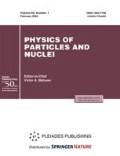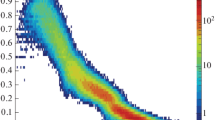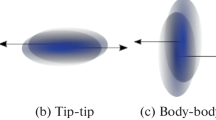Abstract—
In central collisions of heavy relativistic nuclei spectator matter is represented by noninteracting nucleons from the nuclear periphery. In the context of the AAMCC model based on the Glauber Monte Carlo model to determine the volume of spectator matter and the models of the decay of excited spectator matter from the Geant4 toolkit, it is shown that the yields of a certain number of neutrons in central collisions of 208Pb nuclei are sensitive to the presence of the neutron skin. When the neutron skin is considered in the calculations using various parameterizations of the excitation energy of spectator matter, an increase in the yield of spectator neutrons is especially noticeable in the events without the emission of spectator protons. The proposed new method for studying the neutron skin in relativistic nucleus–nucleus collisions by means of zero degree calorimeters complements the known methods used at significantly lower collision energies. It can be implemented at existing experimental facilities.



Similar content being viewed by others
REFERENCES
H. Appelshäuser et al. (NA49 Collab.), “Spectator nucleons in Pb + Pb collisions at 158 A·GeV,” Eur. Phys. J. A 2, 383–390 (1998).
B. Abelev et al. (ALICE Collaboration), “Centrality determination of Pb–Pb collisions \(\sqrt {{{s}_{{NN}}}} \) = 2.76 TeV with ALICE,” Phys. Rev. C 88, 044909 (2013).
C. Loizides, J. Kamin, and D. D’Enterria, “Improved Monte Carlo Glauber predictions at present and future nuclear colliders,” Phys. Rev. C 97, 054910 (2018).
A. Steiner, M. Prakash, J. Lattimer, and P. Ellis, “Isospin asymmetry in nuclei and neutron stars,” Phys. Rep. 411, 325–375 (2005).
C. J. Horowitz and J. Piekarewicz, “Neutron star structure and the neutron radius of 208Pb,” Phys. Rev. Lett. 86, 5647–5650 (2001).
C. A. Bertulani and J. Valencia, “Neutron skins as laboratory constraints on properties of neutron stars and on what we can learn from heavy ion fragmentation reactions,” Phys. Rev. C 100, 015802 (2019).
B. A. Brown, “Neutron radii in nuclei and the neutron equation of state,” Phys. Rev. Lett. 85, 5296–5299 (2000).
M. B. Tsang, J. R. Stone, F. Camera, P. Danielewicz, S. Gandolfi, K. Hebeler, C. J. Horowitz, J. Lee, W. G. Lynch, Z. Kohley, R. Lemmon, P. Möller, T. Murakami, S. Riordan, X. Roca-Maza, F. Sammarruca, A. W. Steiner, I. Vidaña, and S. J. Yennello, “Constraints on the symmetry energy and neutron skins from experiments and theory,” Phys. Rev. C 86, 015803 (2012).
A. Trzcińska, J. Jastrzębski, P. Lubiński, F. J. Hartmann, R. Schmidt, T. von Egidy, and B. Kłos, “Neutron density distributions deduced from antiprotonic atoms,” Phys. Rev. Lett. 87, 082501 (2001).
C. M. Tarbert et al. (Crystal Ball at MAMI and A2 Collab.), “Neutron skin of Pb-208 from coherent pion photoproduction,” Phys. Rev. Lett. 112, 242502 (2014).
C. W. Ma, Y. Fu, D. Q. Fang, Y. G. Ma, X. Z. Cai, W. D. Tian, K. Wang, and C. Zhong, “Isospin effect and isoscaling phenomenon in projectile fragmentation,” Int. J. Mod. Phys. E 17, 1669–1680 (2008).
D. Q. Fang, Y. G. Ma, X. Z. Cai, W. D. Tian, and H. W. Wang, “Neutron removal cross section as a measure of neutron skin,” Phys. Rev. C 81, 047603 (2010).
D. Q. Fang, Y. G. Ma, X. Z. Cai, W. D. Tian, and H. W. Wang, “Effects of neutron skin thickness in peripheral nuclear reactions,” Chin. Phys. Lett. 28, 10–13 (2011).
T. Aumann, C. A. Bertulani, F. Schindler, and S. Typel, “Peeling off neutron skins from neutron-rich nuclei: Constraints on the symmetry energy from neutron-removal cross sections,” Phys. Rev. Lett. 119, 262501 (2017).
M. Alvioli and M. Strikman, “Spin-isospin correlated configurations in complex nuclei and neutron skin effect in W ± production in high-energy proton-lead collisions,” Phys. Rev. C 100, 024912 (2019).
S. De, “The effect of neutron skin on inclusive prompt photon production in Pb + Pb collisions at Large Hadron Collider energies,” J. Phys. G 44, 045104 (2017).
A. O. Svetlichnyi and I. A. Pshenichnov, “Formation of free and bound spectator nucleons in hadronic interactions between relativistic nuclei,” Bull. Russ. Acad. Sci.: Phys. 84, 911–916 (2020).
I. A. Pshenichnov, U. A. Dmitrieva, and A. O. Svetlichnyi, “Secondary nuclei from peripheral and ultraperipheral collisions of relativistic heavy ions,” Bull. Russ. Acad. Sci.: Phys. 84, 1007–1011 (2020).
J. Bondorf, A. Botvina, A. Iljinov, I. Mishustin, and K. Sneppen, “Statistical multifragmentation of nuclei,” Phys. Rep. 257, 133–221 (1995).
J. Allison et al. (Geant4 Collab.), “Recent developments in Geant4,” Nucl. Instrum. Methods Phys. Res., Sect. A 835, 186–225 (2016).
T. Ericson, “The statistical model and nuclear level densities,” Adv. Phys. 9, 425–511 (1960).
A. Botvina, I. Mishustin, M. Begemann-Blaich, J. Hubele, G. Imme, I. Iori, P. Kreutz, G. Kunde, W. Kunze, V. Lindenstruth, U. Lynen, A. Moroni, W. Müller, C. Ogilvie, J. Pochodzalla, G. Raciti, T. Rubehn, H. Sann, A. Schüttauf, W. Seidel, W. Trautmann, and A. Wörner, “Multifragmentation of spectators in relativistic heavy-ion reactions,” Nucl. Phys. A 584, 737–756 (1995).
A. B. Jones and B. A. Brown, “Two-parameter Fermi function fits to experimental charge and point-proton densities for Pb-208,” Phys. Rev. C 90, 067304 (2014).
G. A. Miller, “Coherent-nuclear pion photoproduction and neutron radii,” Phys. Rev. C 100, 44608 (2019).
V. Guzey, E. Kryshen, and M. Zhalov, “Photoproduction of light vector mesons in Xe–Xe ultraperipheral collisions at the LHC and the nuclear density of Xe-129,” Phys. Lett. B 782, 251–255 (2018).
M. B. Golubeva, F. F. Guber, A. P. Ivashkin, A. Y. Isupov, A. B. Kurepin, A. G. Litvinenko, E. I. Litvinenko, I. I. Migulina, and V. F. Peresedov, “Nuclear-nuclear collision centrality determination by the spectators calorimeter for the MPD setup at the NICA facility,” Phys. At. Nucl. 76, 1–15 (2013).
V. Golovatyuk, V. Kekelidze, V. Kolesnikov, O. Rogachevsky, and A. Sorin, “Multi-purpose detector to study heavy-ion collisions at the NICA collider,” Nucl. Phys. A 982, 963–966 (2019).
D. A. Bauer, D. V. Karlovets, and V. G. Serbo, “Bound-free pair production in relativistic nuclear collisions from the NICA to the HE LHC colliders,” Eur. Phys. J. A 56, 4–8 (2020).
B. Kłos, A. Trzcińska, J. Jastrzębski, T. Czosnyka, M. Kisieliński, P. Lubiński, P. Napiorkowski, L. Pieńkowski, F. J. Hartmann, B. Ketzer, P. Ring, R. Schmidt, T. von Egidy, R. Smolańczuk, S. Wycech, K. Gulda, W. Kurcewicz, E. Widmann, and B. A. Brown, “Neutron density distributions from antiprotonic Pb-208 and Bi-209 atoms,” Phys. Rev. C 76, 014311 (2007).
ACKNOWLEDGMENTS
I.A. Pshenichnov is grateful to Dariusz Miskowiec and Chiara Oppedisano for the discussions that paved the foundation for this work.
Funding
This work was supported by the Russian Foundation for Basic Research, project no. 18-02-40035-mega.
Author information
Authors and Affiliations
Corresponding author
Ethics declarations
The authors declare that they have no conflicts of interest.
Additional information
Translated by I. Obrezanova
Rights and permissions
About this article
Cite this article
Pshenichnov, I.A., Kozyrev, N.A., Svetlichnyi, A.O. et al. What One Can Learn by Studying Spectator Remnants in Central Nucleus–Nucleus Collisions?. Phys. Part. Nuclei 53, 335–341 (2022). https://doi.org/10.1134/S1063779622020691
Received:
Revised:
Accepted:
Published:
Issue Date:
DOI: https://doi.org/10.1134/S1063779622020691




